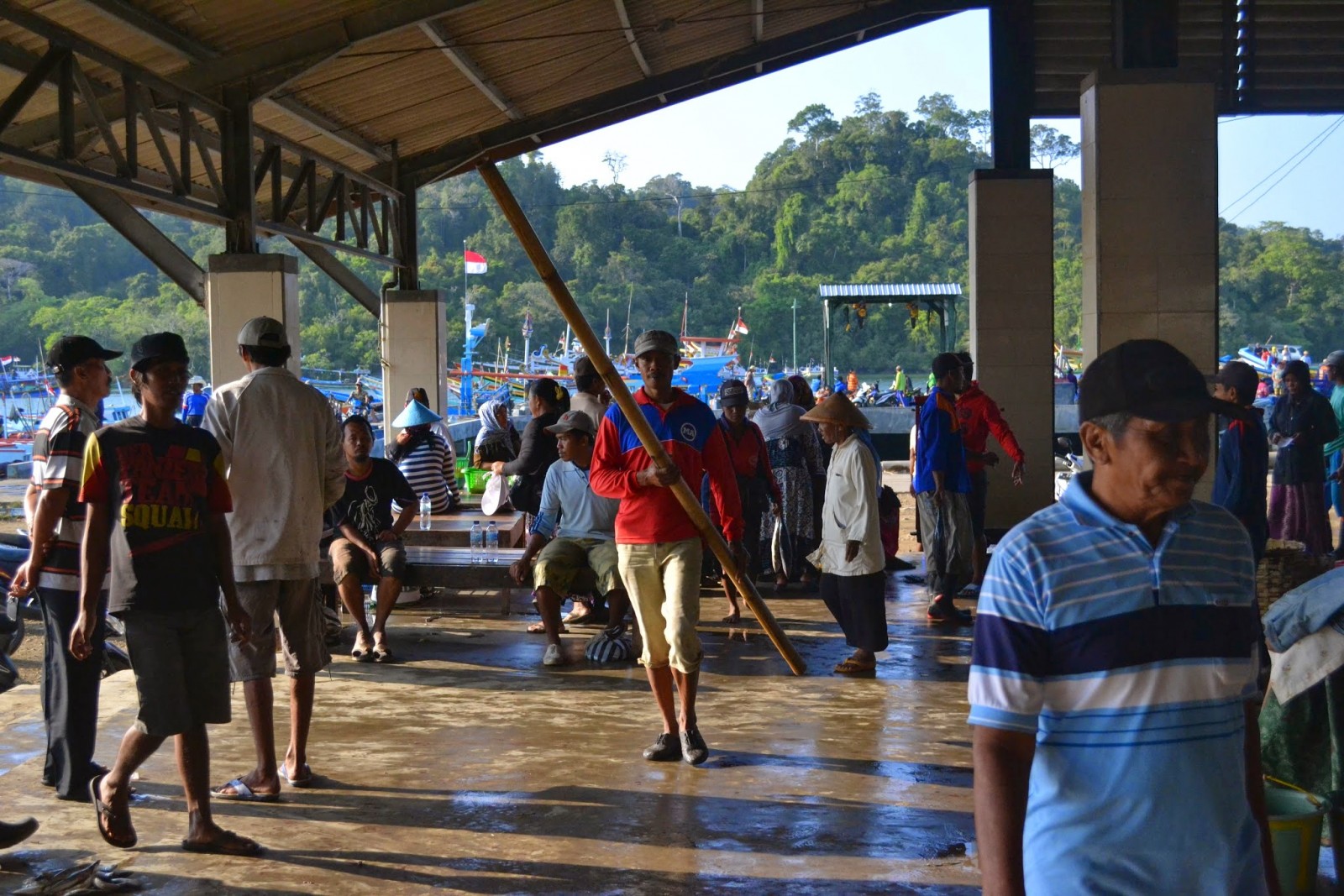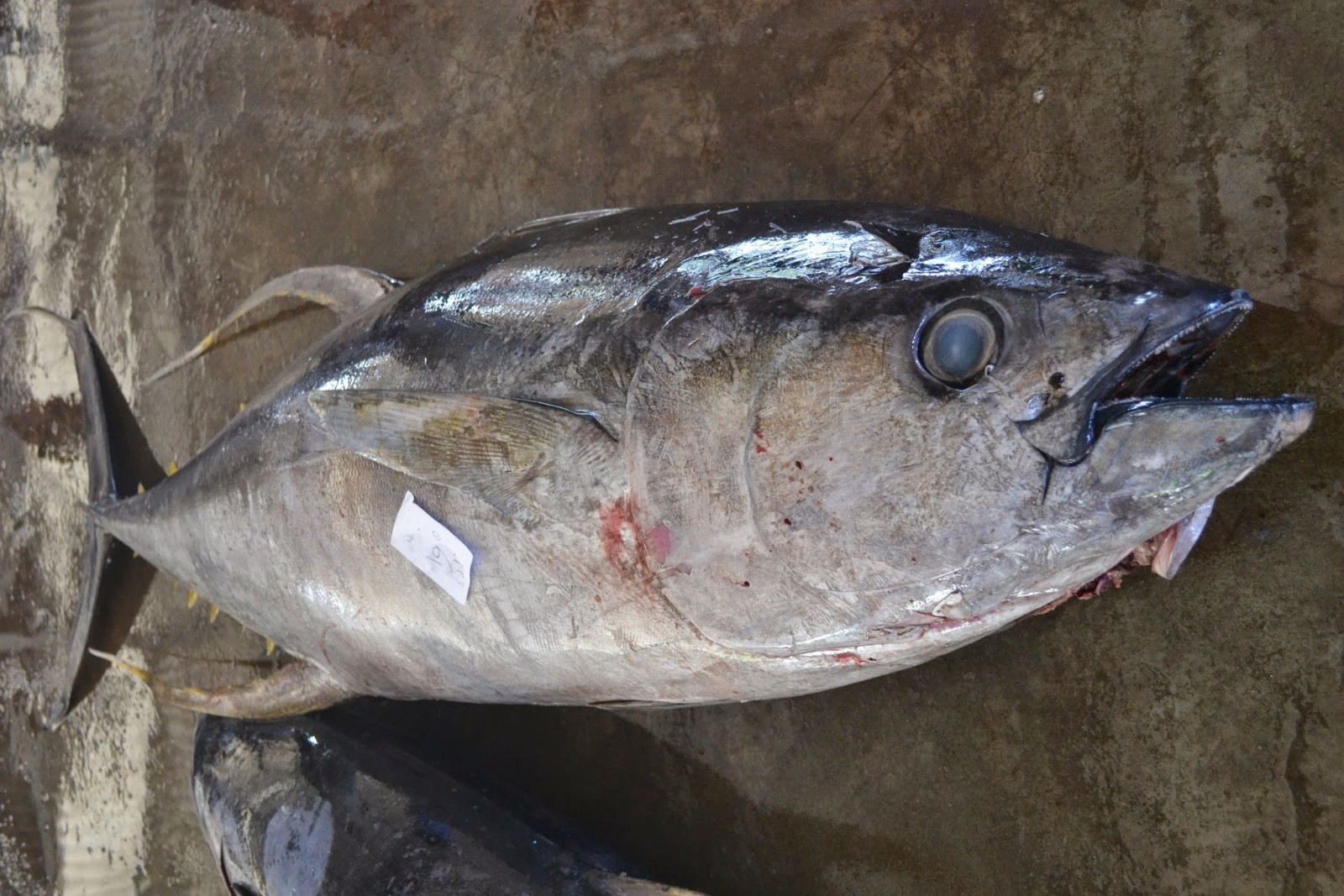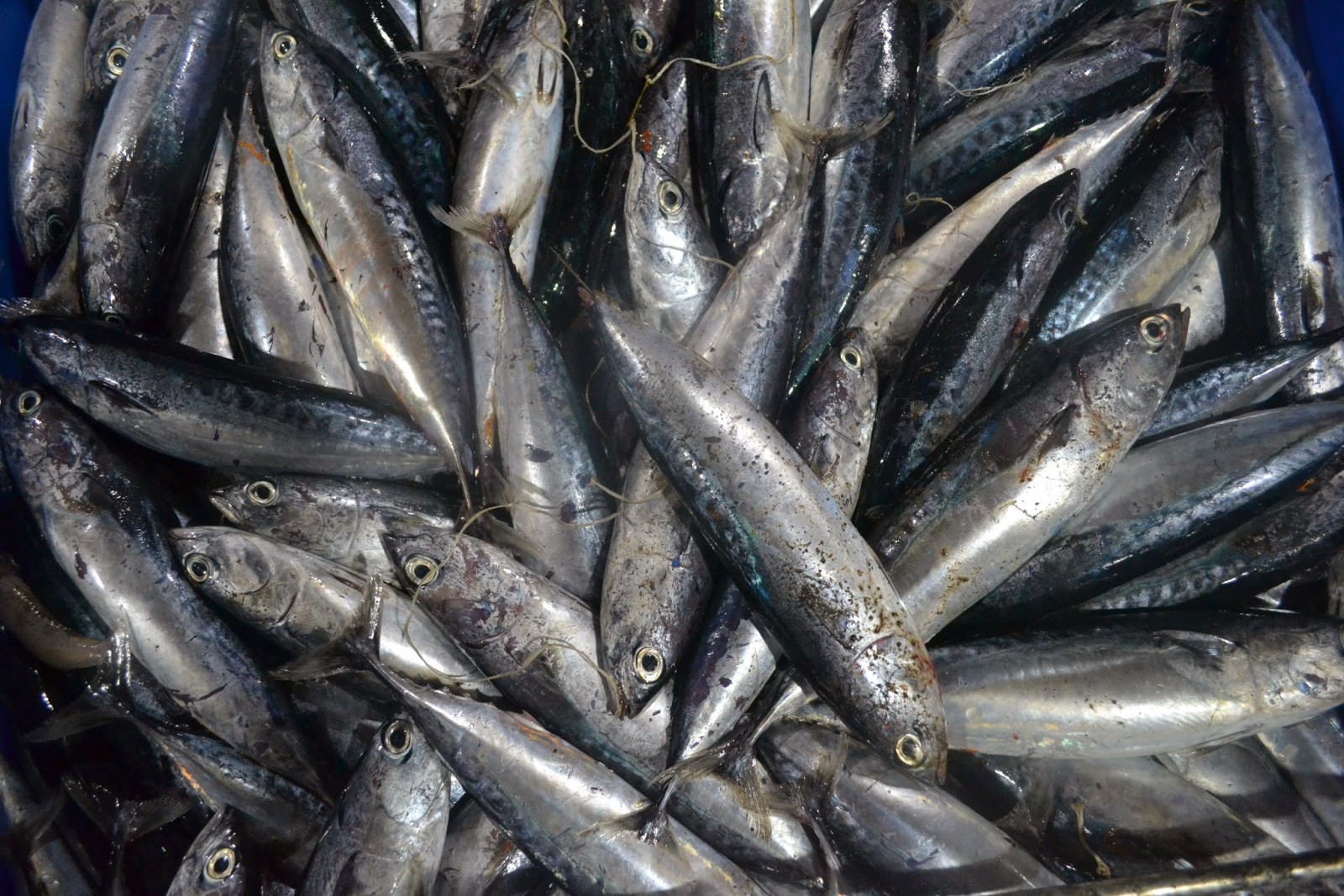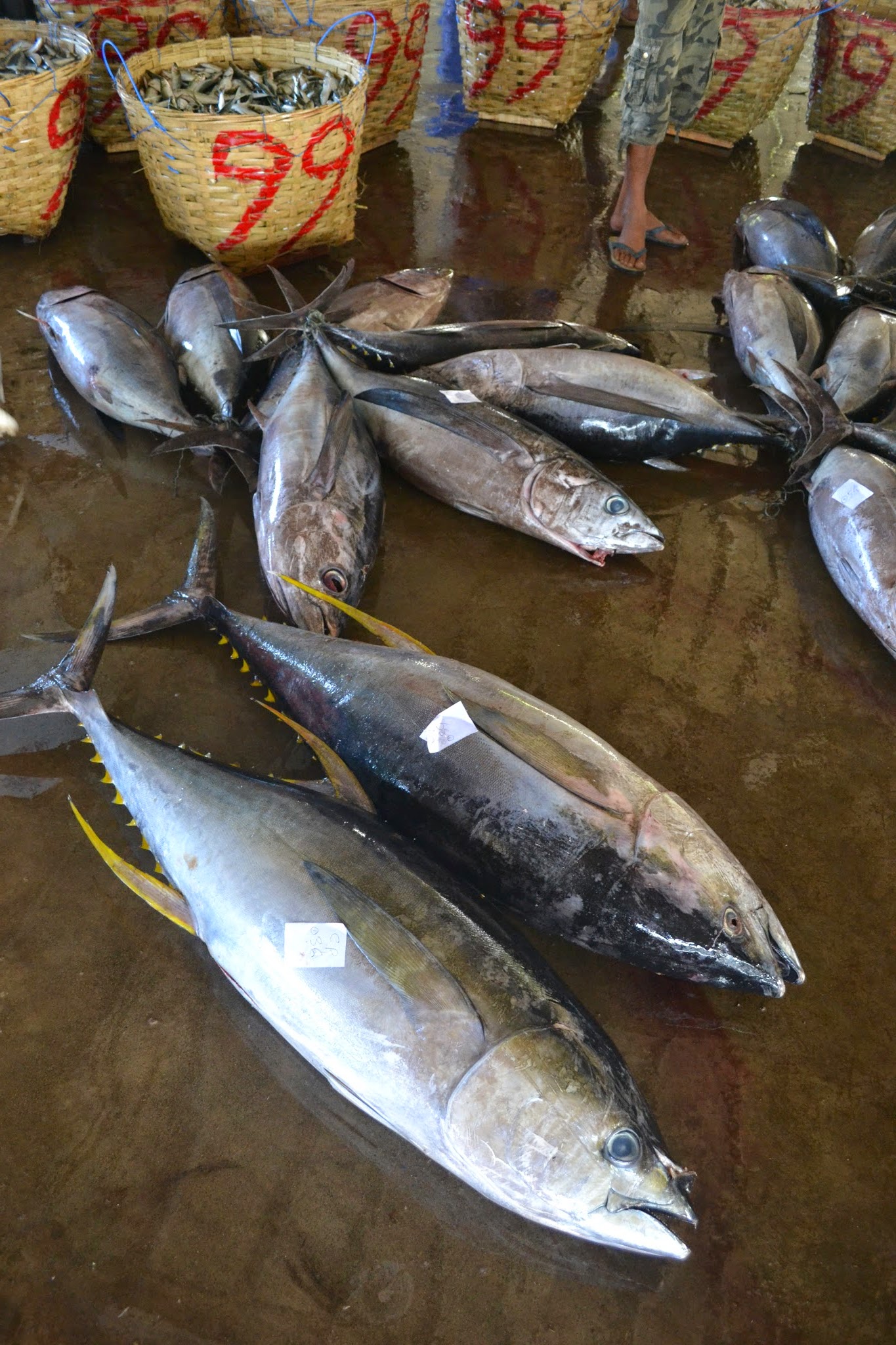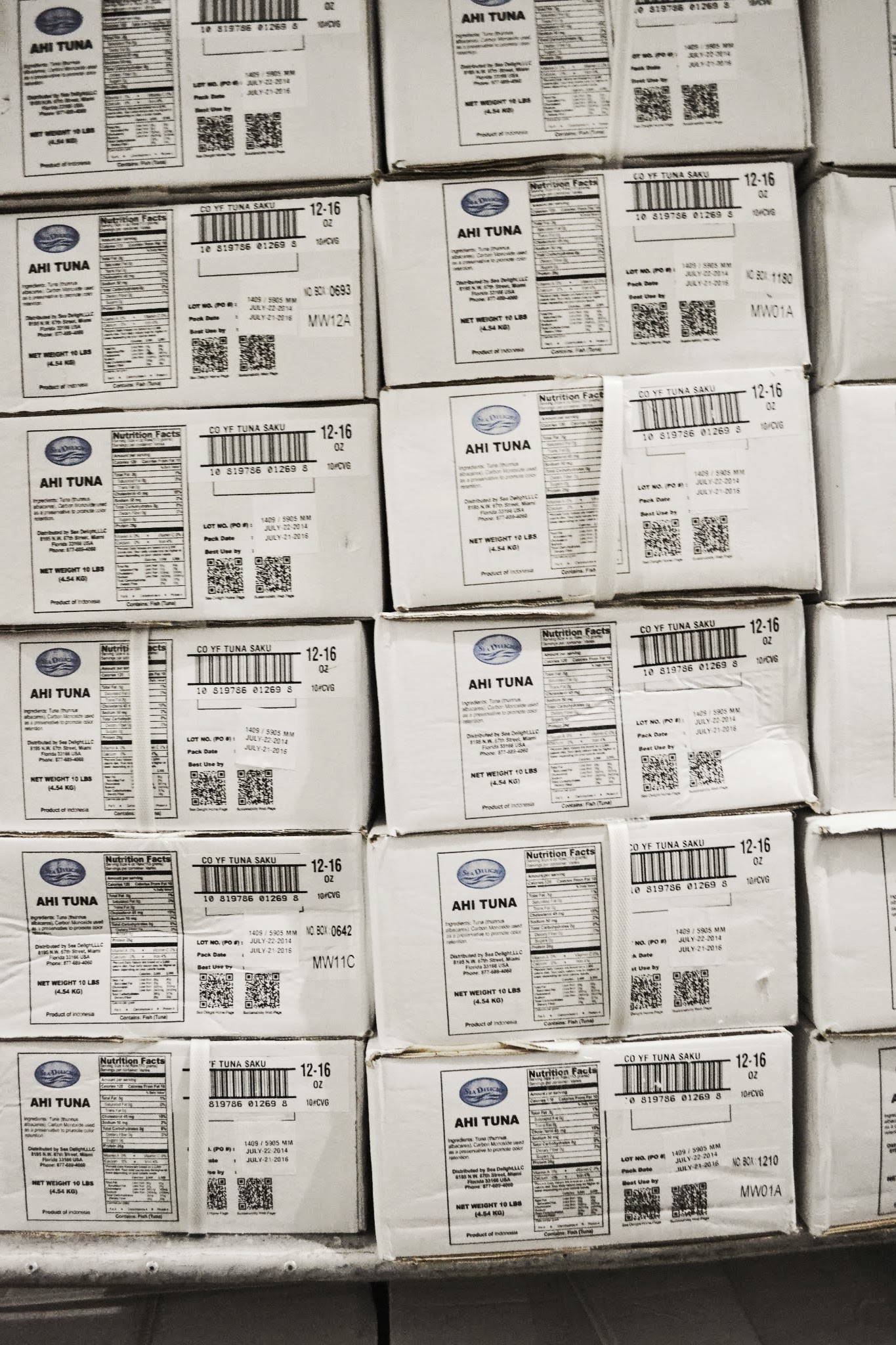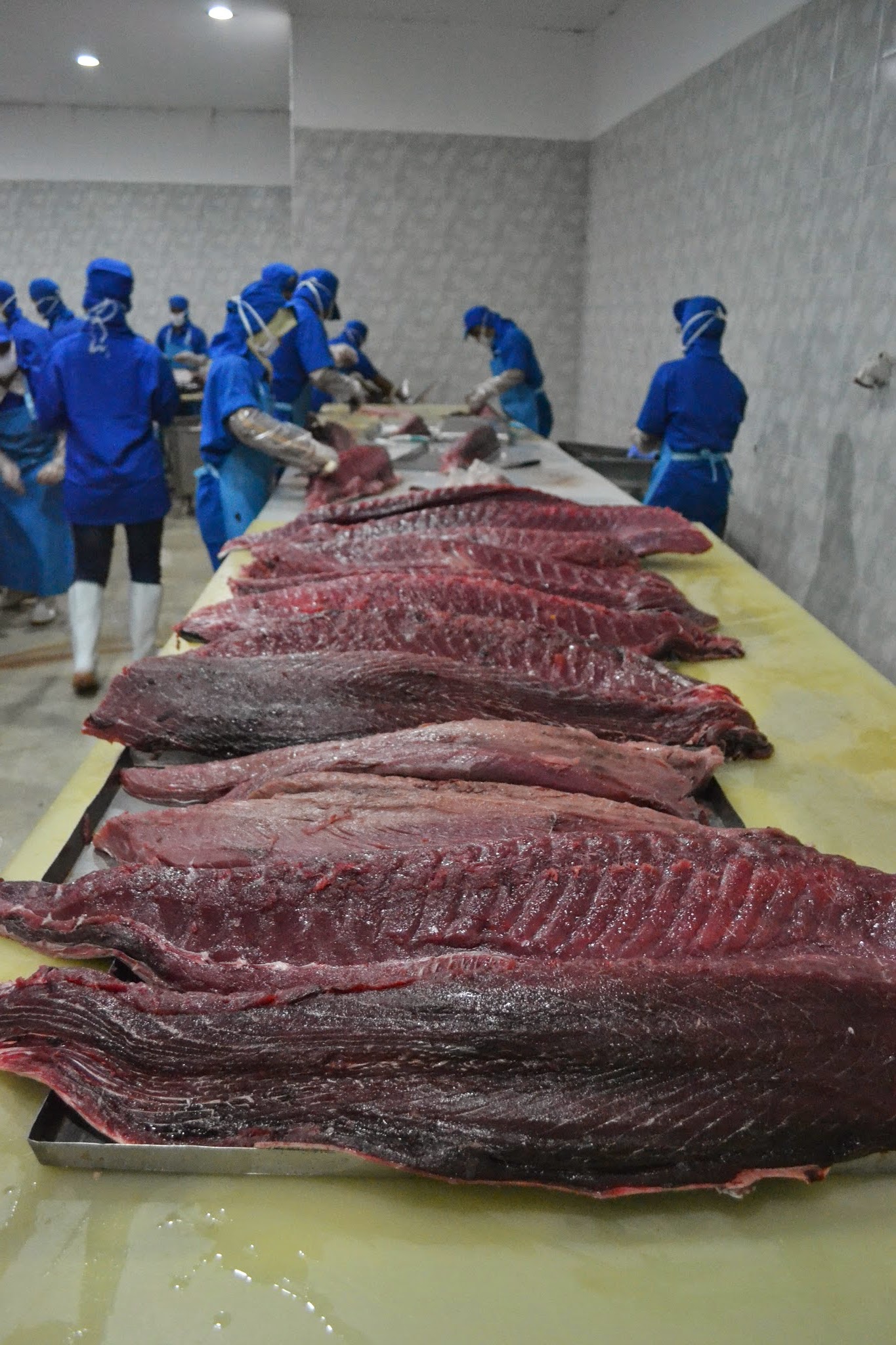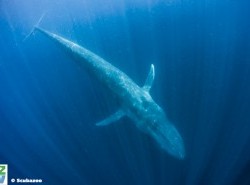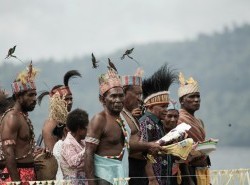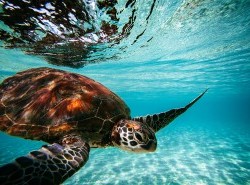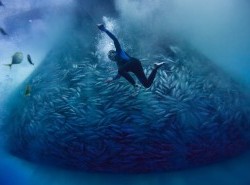In the cool hours of early morning, they start trickling into this small Indonesian harbour—rickety fishing boats that are returning home after up to one gruelling month at sea. Before long, hundreds of tuna are strung on bamboo poles and unloaded for weighing and on-the-spot auction selling on the docks. But for how long can the bonanza continue before stocks collapse?
I am here with a team from WWF-Indonesia, which is working with the fishing community of Sendang Biru, East Java, in the hope of improving the management of yellowfin tuna, not just here, but throughout the Indian Ocean.
At first look, Sendang Biru looks just like any other Indonesian fishing village. On the day we’re visiting, it is still decked out in the national colours to mark Indonesia’s Independence Day, with plastic cups painted red and white hanging from lines on either side of the streets. Here and there, oversized effigies of fish are receiving the finishing touches before the local carnival gets under way. But the settlement is also the scene of a race against the clock to save tuna stocks in the Indian Ocean, and to ensure the long-term survival of the fishing industry.
Indonesia is the biggest tuna-producing country in the world, with Japan, US, Thailand and EU countries the main importers of this thriving industry. After shrimp, tuna is the second largest Indonesian fishery, generating a whopping USD 750 million in 2012 (more than double the export value in 2008) according to Indonesia’s Ministry of Marine Affairs and Fisheries. The numbers may impress, but there are signs that this economic engine is beginning to run on fumes.
Boats have to go further to catch fish—sometimes up to 250 nautical miles away. As a result, fishermen are away at sea longer, which increases their costs and their exposure to risk. It is not unheard of for boats to run out of gas while they’re hundreds of miles away from the coast, a chance encounter with another boat their only hope of making it back to port.
As we watch the frenzy of tuna weighing and trading at the harbour, Steve explains that for his firm, sustainability is no longer a choice, it’s a neccessity. “Yesterday, I received about 80 emails from my customers. One out of four was asking me questions related to sustainability. Our buyers want to know where our seafood comes from, how it is caught, if it is contributing to bycatch and so on.” With overfishing and the abuse of oceans more visible than ever in the media, Sea Delight is feeling the brunt of public concern over the wellbeing of marine life.
When business owners rise to the challenge, they roll up their sleeves and sit down with WWF to figure out how their business can thrive without harming oceans and marine life. One of the first businesses to sign up to Seafood Savers was Sea Delight, and what we were seeing around us in Sendang Biru is partly the fruit of that collaboration.
The fishing community of Sendang Biru has probably undergone more changes in the last few years than it has over the last decades, with tuna now landed in an improved dock and sold through an auction—a rare occurrence in Indonesia. A lot of that owes to WWF, but also to Pak Goentoro Soepardi, a driven man who heads the local fisheries government unit. One of his first priorities has been to figure out just how much tuna locals are taking out of the water.
At first look, Sendang Biru looks just like any other Indonesian fishing village. On the day we’re visiting, it is still decked out in the national colours to mark Indonesia’s Independence Day, with plastic cups painted red and white hanging from lines on either side of the streets. Here and there, oversized effigies of fish are receiving the finishing touches before the local carnival gets under way. But the settlement is also the scene of a race against the clock to save tuna stocks in the Indian Ocean, and to ensure the long-term survival of the fishing industry.
Indonesia is the biggest tuna-producing country in the world, with Japan, US, Thailand and EU countries the main importers of this thriving industry. After shrimp, tuna is the second largest Indonesian fishery, generating a whopping USD 750 million in 2012 (more than double the export value in 2008) according to Indonesia’s Ministry of Marine Affairs and Fisheries. The numbers may impress, but there are signs that this economic engine is beginning to run on fumes.
A massive industry on shaky ground
In the absence of a robust mechanism to collect data, estimates of the amount of tuna that passes through Sendang Biru vary depending on who you talk to. But whether it’s the fishermen wearily walking back home after two weeks at sea or the local middleman, the verdict is always the same: it’s getting harder and harder to bring tuna out of the sea, and the fish are getting a whole lot smaller. Local experts concur, suggesting that tuna catch peaked in 2007 and has been declining year on year since then.Boats have to go further to catch fish—sometimes up to 250 nautical miles away. As a result, fishermen are away at sea longer, which increases their costs and their exposure to risk. It is not unheard of for boats to run out of gas while they’re hundreds of miles away from the coast, a chance encounter with another boat their only hope of making it back to port.
When tuna buyers begin to worry
The situation worries not only WWF but stakeholders across the tuna supply chain, including Steve Fisher, Asia Pacific General Manager for Sea Delight, a Miami-based company specializing in high-end seafood products that also sources from Sendang Biru (through its local supplier, CV Giovanni Sukses Makmur). He’s joined us on this visit.As we watch the frenzy of tuna weighing and trading at the harbour, Steve explains that for his firm, sustainability is no longer a choice, it’s a neccessity. “Yesterday, I received about 80 emails from my customers. One out of four was asking me questions related to sustainability. Our buyers want to know where our seafood comes from, how it is caught, if it is contributing to bycatch and so on.” With overfishing and the abuse of oceans more visible than ever in the media, Sea Delight is feeling the brunt of public concern over the wellbeing of marine life.
Food safety and sustainability, two sides of the same coin
Steve is also concerned about tuna hygiene. Pointing at several workers washing down the tuna landing area with water taken from the less-than-pristine harbour, he explains that such practices not only affect fish quality, but also reduce their market price. For this veteran of the seafood trade, a priority for Sendang Biru is to improve the way tuna is handled at the docks (potentially boosting the harbour’s market reputation), a concern that is echoed by the middlemen who expect the government to further improve the local facilities. Everyone in the supply chain stands to benefit from such improvements.Saving seafood, saving an industry
Spawned from the realization that sustainable seafood is also the business of the ‘movers and shakers’ who buy and sell this valuable commodity, WWF-Indonesia’s Seafood Savers programme was set up in 2009 to work with the industry and help set it on a more sustainable path. For WWF-Indonesia’s Margareth Meutia and her colleagues, this has meant spending months talking to seafood venture owners and inviting them to join Seafood Savers.When business owners rise to the challenge, they roll up their sleeves and sit down with WWF to figure out how their business can thrive without harming oceans and marine life. One of the first businesses to sign up to Seafood Savers was Sea Delight, and what we were seeing around us in Sendang Biru is partly the fruit of that collaboration.
The fishing community of Sendang Biru has probably undergone more changes in the last few years than it has over the last decades, with tuna now landed in an improved dock and sold through an auction—a rare occurrence in Indonesia. A lot of that owes to WWF, but also to Pak Goentoro Soepardi, a driven man who heads the local fisheries government unit. One of his first priorities has been to figure out just how much tuna locals are taking out of the water.
Tuna is filleted at the processing plant of CV Giovanni Sukses Makmur, a major tuna supplier, in the industrial city of Surabaya
Photo: Marc-Antoine Dunais
Changing practices and mindsets
For generations, fishers here have caught and sold fish with few incentives to keep a tally of their catch. As long as they could make a profit and feed their families, their needs were met. The problem is that if you don’t know how much you’re catching, it is very difficult to determine how much fish there is in the sea. And if you don’t know how big your stocks are, it’s near impossible to determine how much fish you can catch before you literally write off your supply.Sitting in his office that overlooks the small bay of Sendang Biru, Pak Goentoro explains he has made it mandatory for captains to register their boats, and log every single one of their fishing trips and their catch. If they want to head out to sea, it is compulsory for them to check in at his office to sort out their paperwork.
For fishermen with little exposure to such administrative tasks, complying with this seemingly basic requirement is already a huge leap forward. Talking with a local observer, I am told that many captains consider the new regulation a nuisance and end up ‘guesstimating’ the data to be filled in their logs in a hurry, just before they dock. Log sheets get wet—sometimes they just disappear at sea.
At the very least, the new rules are driving the notion that practices need to change, and are resulting in more awareness by fishermen that they need to abide by them. And Pak Goentoro means business. He has gone as far as to sentence a local fisherman to prison for not having a complete license, a practice described as “shock therapy” by a local tuna middleman.
From FIP to MSC
There is still a long way to go. For WWF and Sea Delight, the prized but elusive “Eldorado” for the tuna fishery in Sendang Biru is certification by the Marine Stewardship Council (MSC). The MSC is one of a growing number of organizations globally (many set up by WWF, such as this one) that define standards for the sustainable production of popular commodities - think palm oil, soy, shrimp, sugar, and tuna. The MSC works with independent certification consultancies that carry out on-the-ground checks to verify that its member companies are adhering to the standards.It’s hard to reconcile the sight of a traditional, ramshackle local fishery with the rigour of an international certification scheme and its check-lists. To ease this transition, WWF has introduced the so-called Fishery Improvement Project (FIP), a stepping stone towards MSC. Seafood Savers’ FIP in East Java is all about giving technical input across the supply chain to implement sustainable fishing practices. Among other things, this involves promoting the use of nets with specific mesh sizes (to avoid catching juvenile fish that have not reproduced yet) and training crews on how to disentangle—and release back to sea—marine turtles that are caught unintentionally. For WWF, this is a long haul investment that involves immersing staff in the fishing community to earn their trust and to slowly begin sowing the seeds of change.
---
One day later, we are tearing down the brand new highway that brings us to Surabaya, on the north coast of Java, some 6-7 hours away from Sendang Biru. Here, in a non-descript industrial suburb, we come once more face to face with the tuna we had seen on the docks.
Fifty percent drop
In the processing plant of CV Giovanni Sukses Makmur, which sources its tuna from Sendang Biru and sells to Sea Delight for export, the din of fishermen’s banter has been replaced by the swishing of knives and the thud of slabs of tuna meat, speedily processed by an ultra-efficient human conveyor belt. An army of blue-clad workers swing tunas, skin them, and dismember them until all that remains is a row of neatly packaged, bright red tuna pieces that will end up in a deep freezer, ready for export to the US or Japan. But the frenetic pace on the factory floor and the seemingly constant flow of tuna masks a fundamental problem—a 50% drop in the tuna supply since 1999, according to owner Liem Lian Hwa.It is tempting to ascribe the reduction in tuna supply to dwindling stocks. However, according to Abdullah Habibi, WWF-Indonesia’s Fisheries and Aquaculture Improvements Manager, the yellowfin tuna stock that Sendang Biru’s fishing fleet depends on is not overfished as suggested by the Indian Ocean Tuna Commission, a regional organization working to manage the tuna fishery in the Indian Ocean. In fact, he suspects that Ms Lian Hwa is finding it difficult to source tuna because of competition with a growing number of exporters who are elbowing their way into the sector.
Going East
For exporters, the traditional response to dwindling fish supplies has been to look elsewhere, pushing deeper into new fishing grounds—in Indonesia, that means further to the East. But as the tuna industry scrambles to secure a steady supply of fish in the face of growing competition, businesses such as CV Giovanni Sukses Makmur are mindful that they need to apply the same sustainability requirements to meet their buyers’ demands, which prevents them from buying tuna indiscriminately.With more seafood companies joining WWF’s Seafood Savers, and more buyers demanding “eco-friendly” tuna, the standard for the tuna industry will increasingly favour those players who recognize that the rules of the game are changing. For artisanal fishermen who have fished the same way for decades thinking only about tomorrow, the transition will require a revolutionary adaptation and some degree of modernization.
This may be their best hope yet that their children can continue to profit from the industry and healthy oceans.
